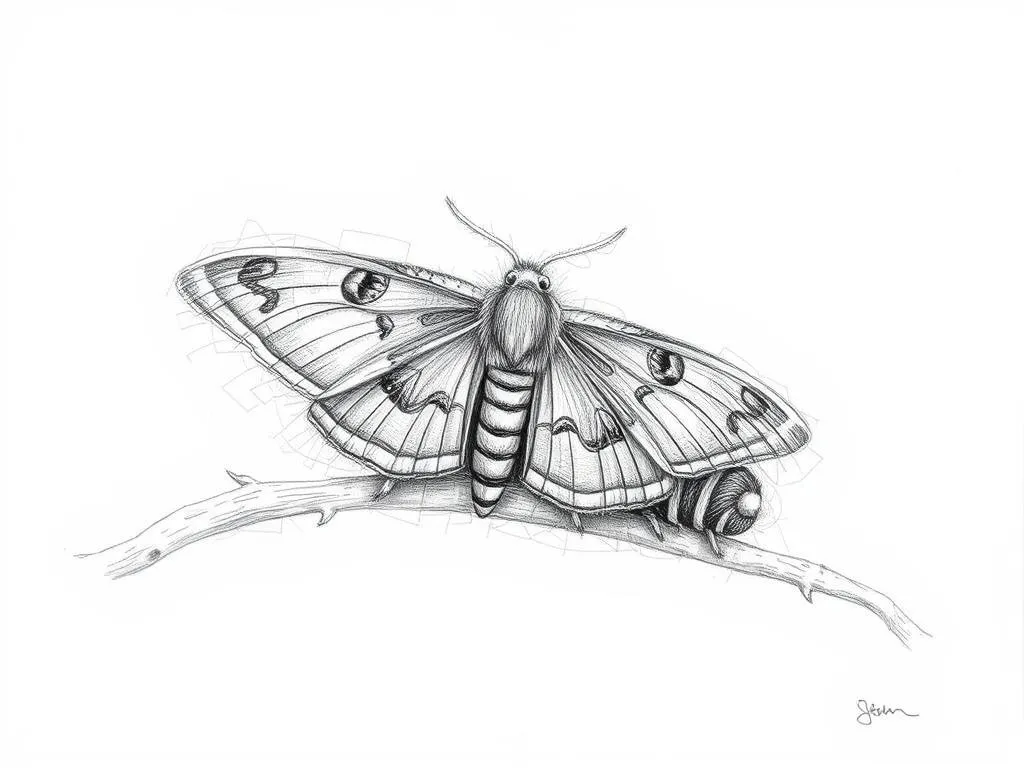Gypsy Moth Caterpillar: A Journey of Transformation and Resilience

Disclaimer: Some images on this website are AI-generated artworks and may not accurately represent real animals.
The gypsy moth caterpillar carries profound symbolism and meaning that transcends its biological existence. As it embarks on its remarkable life cycle, this creature embodies themes of transformation, adaptability, and resilience. In this blog post, we will explore the biological characteristics of the gypsy moth caterpillar, its cultural significance, and the deeper meanings associated with its existence.
Understanding the Gypsy Moth Caterpillar
Biological Overview
The gypsy moth caterpillar, scientifically known as Lymantria dispar, is an intriguing insect that undergoes a fascinating transformation.
| Physical Characteristics | Details |
|---|---|
| Color | Early instars are greenish; older caterpillars are hairy with blue and red tubercles. |
| Size | Can grow up to 2.5 inches long. |
| Life Cycle | Four stages: egg, larva (caterpillar), pupa, and adult moth. |
| Habitat | Prefers deciduous forests, but can adapt to various habitats. |
| Behavior | Known for its voracious appetite, especially for oak leaves. |
The life cycle of the gypsy moth begins with eggs laid in masses. Once the eggs hatch, the caterpillars emerge and start feeding voraciously on the leaves of trees. This feeding frenzy is crucial as it prepares them for the transformation into their adult form. After several molts, the caterpillars enter the pupal stage, eventually emerging as adult moths.
Cultural Significance
The gypsy moth has a complex relationship with cultural narratives. Historically, the term “gypsy” has been associated with the Romani people, a group often linked to themes of wandering and change. While the connection can be seen as a metaphor for the gypsy moth caterpillar‘s journey through life, it is essential to approach this symbolism with sensitivity to cultural nuances.
In folklore, the gypsy moth has been woven into various myths, often depicting it as a harbinger of change or a reminder of the transient nature of life. Many cultures view the caterpillar as a symbol of personal transformation, where the struggle for survival leads to beauty and renewal.

Symbolism & Spiritual Meaning
Transformation and Rebirth
The gypsy moth caterpillar exemplifies the theme of transformation and rebirth through its metamorphosis. This process is not merely a biological change; it represents the potential for personal growth and new beginnings. Just as the caterpillar sheds its old skin, individuals can embrace change, leaving behind limiting beliefs and behaviors to step into their true selves.
The metamorphosis from caterpillar to moth serves as a powerful reminder that transformation often requires patience and resilience. It encourages us to embrace our own journeys of change, no matter how challenging they may appear.
Adaptability and Resilience
Another significant aspect of the gypsy moth caterpillar symbolism is its adaptability and resilience. These caterpillars can thrive in various environments, demonstrating the ability to overcome adversity. Their presence in different habitats highlights the importance of flexibility and being open to new experiences.
In a world that is constantly changing, the lessons of adaptability from the gypsy moth caterpillar can inspire individuals to navigate challenges with grace. By embracing change and finding ways to thrive, we can draw strength from the caterpillar’s journey.
The Role of Nature’s Cycles
Nature operates in cycles, and the gypsy moth caterpillar is a vital part of this rhythm. Seasonal changes influence its life cycle, reminding us of the importance of regeneration and renewal in our own lives. Each season brings its own unique challenges and opportunities for growth.
The caterpillar’s emergence in spring symbolizes a time of awakening and rebirth. It serves as a reminder that just as nature transforms with the seasons, we can also experience periods of growth and change. Embracing these cycles allows us to find harmony within ourselves and our surroundings.
Gypsy Moth Caterpillar in Dreams
Interpretation of Dreams Featuring Gypsy Moths
Dreams featuring the gypsy moth caterpillar can carry significant meanings. They often reflect themes of personal growth, transformation, and the need for change.
| Common Themes | Messages |
|---|---|
| Transformation | Indicating a period of change in life. |
| Intuition | A call to trust one’s inner guidance. |
| Resilience | Encouragement to overcome challenges. |
| New Beginnings | Signaling the start of a fresh chapter. |
These dreams may manifest during times of transition, such as starting a new job, moving to a new location, or ending a relationship. The gypsy moth caterpillar serves as a symbol of the internal changes that accompany these external shifts.
Connecting with Intuition
The presence of the gypsy moth caterpillar in dreams can also signify intuition and inner guidance. It encourages individuals to listen to their instincts and trust their journey. Just as the caterpillar instinctively knows when to transition into the next stage of its life, we, too, can learn to honor our inner voice.
By paying attention to these dreams, individuals can gain valuable insights into their personal growth and the changes they are experiencing. Embracing the wisdom of the gypsy moth caterpillar can enhance self-awareness and encourage proactive steps toward transformation.
Modern Interpretations
Environmental Awareness
In contemporary discussions, the gypsy moth caterpillar serves as a symbol of environmental awareness. Its role in ecosystems is significant, as it impacts tree health and biodiversity. While its voracious appetite can lead to ecological challenges, it also highlights the delicate balance of nature.
The gypsy moth caterpillar’s presence reminds us of the importance of maintaining ecological balance and respecting the interconnectedness of all living beings. It encourages individuals to reflect on their relationship with nature and consider how their actions impact the environment.
Cultural Representations
The gypsy moth caterpillar has also found its way into modern art and literature, where it is often depicted as a symbol of transformation and resilience. Contemporary artists and writers explore its symbolism in various contexts, highlighting themes of personal growth, change, and the beauty of nature’s cycles.
In modern spirituality and psychology, the gypsy moth caterpillar is embraced as a powerful symbol of transformation. It inspires individuals to confront their fears, embrace change, and embark on journeys of self-discovery.
Key Takeaways
- Transformation and Rebirth: The gypsy moth caterpillar symbolizes significant life changes and personal growth.
- Adaptability and Resilience: It teaches lessons on overcoming adversity and thriving in new environments.
- Nature’s Cycles: The seasonal changes reflect the importance of regeneration and renewal in our lives.
- Intuition and Inner Guidance: Dreams featuring the caterpillar encourage individuals to trust their instincts and embrace their journey.
- Environmental Awareness: The caterpillar represents the delicate balance of ecosystems and the need for ecological consciousness.
Conclusion
The gypsy moth caterpillar serves as a profound guide for embracing change and transformation. Its journey from caterpillar to moth symbolizes the potential for personal growth and resilience in the face of life’s challenges. By reflecting on the insights provided by this remarkable creature, we can learn to navigate our own journeys with grace and courage.
As we continue to grow and adapt in our lives, let us embrace the lessons of the gypsy moth caterpillar. By welcoming transformation, trusting our intuition, and respecting the rhythms of nature, we can embark on our paths of self-discovery and fulfillment. The journey is ongoing, and each stage of growth brings new opportunities for renewal and rebirth.







